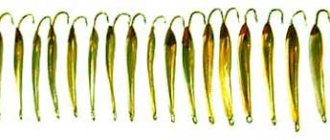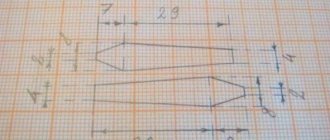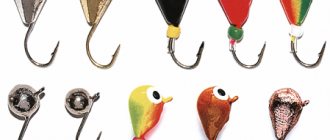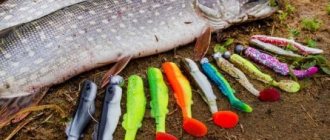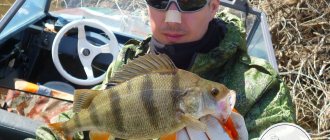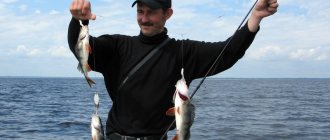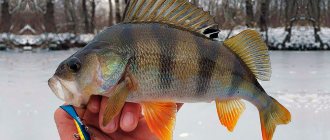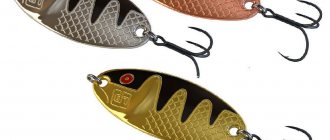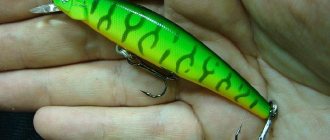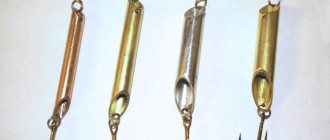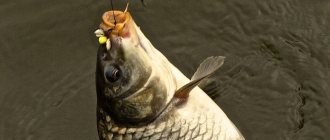What are spinners?
Spinner is the most catchy and easy to use bait. Oscillators have different sizes, shapes, and colors. Each option also has its own vibration frequency.
The spoon is the oldest bait with which you can catch predatory fish. Experienced fishermen observed how crucian carp or perch behave in the water. Oscillating spoons convey these movements of fish in the water.
It is necessary to add game elements to fishing - create movements that attract prey. Recreate the fluttering sounds of a wounded fish or one that is very frightened and is trying to swim away from a dangerous area as quickly as possible.
Lately, fishermen have been buying “wobblers” and forgetting about the main thing - our ancestors used to fish with spoons and did it successfully. They have been used for centuries. Unfortunately, this type of bait is undeservedly fading into the background.
But oscillators are still often used and they could not be replaced by modern purchased devices.
Spoons for vertical spinning
Many anglers pay special attention to spoons. Good play of a spinner is the main requirement for it. Experienced fishermen adjust almost all purchased spinners, sparing neither time nor effort. The spoons are bent in the first third of the head part (at the hook), and the solder layer is increased or decreased. The tackle is finally adjusted in a pond or in a bath of water. At the same time, they achieve not only the desired play of the spinner, but also develop and consolidate options for the best movements with the rod, and determine the size of pauses between cycles of movements.
The color of the spinners used is, naturally, limited by the colors of the metal used for their manufacture and its combinations when soldering spinners from two plates of multi-colored metal. The most commonly used are silver, lead, brass and copper. Many people believe that the best colors are silver or silver-plated and lead lures. Brass and copper in most cases are silvered on the front side. Combined spoons are usually large and are used for catching pike perch and pike perch.
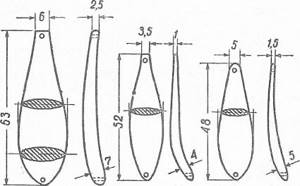
It is known that in winter it is recommended to fish with lighter spoons than in open water. Once, on the last ice, I tried spinners made of polished duralumin. The results of fishing in clear weather in water slightly clouded by melting snow turned out to be good. At the same time, I tied red wool to the hooks and planted white and black beads. The movement of the spinners in the water after a jerk upward depends on the position of the hook, the size of the hairs and the beads worn. To prevent spinners from twisting, it is advisable to equip them with snap hooks. The three most catchy spoons are shown in the figure and have red “eyes” in the head, made with a five-millimeter drill and filled with paint. The hooks are triple, suspended on winding rings.
The best color options for the spinner: the front side is silver, the back side is copper and brass.
To catch perch and pike perch at a depth of more than 4 meters, use spinners with a soldered-in piece of a mirror or a thermos flask. The fragment is rounded, its diameter should be 2-3 millimeters less than the largest width of the spoon; solder it at a distance of 0.5-1 centimeter from the end of the head part. It is considered mandatory for all spinners to paint the fore-end of the hook red.
Depending on the lighting and other conditions, spinners of one color or another are used. On reservoirs with a dark, muddy bottom, low-transparency water, especially if light-colored fry predominate (redheads, rafts, etc.), it is better to fish with silver and silver-plated spoons, as well as in cloudy weather. On reservoirs with a light, sandy bottom, clear water, where dark-colored fry predominate (perch, pike-perch, minnows, etc.), a cast lead spoon will be the best, as well as in conditions of bright sunlight. Lead spoons are especially readily grabbed large perches and pike perch in water bodies abundantly populated with ruff.
The use of heavy or light spinners is determined by the current and depth of the fishing spot:
- in rivers with strong currents and at depths of more than 6 meters, use heavy spoons of convex shapes;
- In the shallow waters of lakes and reservoirs, light spoons are used, in which tin solder is placed only in the head part, near the hook. These spoons are less convex. Often they make lures-plates - from one piece of metal along with a hook (without a barb).
Heavy lures are equipped with 1 or 2 hooks with a barb or a hanging tee; light ones - with hooks both with and without a barb, and sometimes with a needle.
For fishing with bait, heavy spoons are selected and adjusted, each for a specific bait - fry, a piece of worm, fish eye, bloodworm. Sometimes, for this purpose, light spinners are weighed down with additional soldering.
There is a huge range of spinners, different in shape, color, size and equipment. However, experience shows that there is no need for such variety; it is quite possible to get by with just a few baits, since the main thing is the ability to play the lure in such a way as to attract a predator even when it is full.
The essence of glitter
Perch, pike or other fish approach the spoon because it produces vibrations that spread through the water in all directions. Vision, which is weak in fish, plays a far from primary role in the search for food. Therefore, the scales, sometimes quite thinly embossed or painted on the body of the spoon, actually do not have the same significance for the fishing success for which they are designed, as well as other decorations. However, the opinion that the surface of the spoon should have tubercles, pits, etc. is apparently correct: there is no perfectly smooth surface in nature, and the fish are afraid of it. You should also not polish the lure very brightly, to a mirror shine: silver-plated fish take more readily than nickel-plated ones.
Do-it-yourself spinners for sheer trolling are made mainly from brass, stainless steel, various alloys, and are weighted with tin, soldering it on the inside of the spinner (the location of the center of gravity of the bait is also changed with tin). There is no need for a metal leash - the predator does not have time to swallow the bait, since the hooking occurs at the moment of the bite. Small spoons are usually equipped with a soldered single hook, sometimes with two; Large baits are equipped with a tee, which is several millimeters wider than the spinner.
Despite the fact that in the summer, catching perch with a vertical spoon with a blind (soldered) hook can be very successful, during the period when there are many fry in the reservoir, the perch does not bite on such a spoon or bites very rarely. In such situations, some anglers suggest supplementing the lure with a movable (at the time of play) hook. To do this, hook No. 5-6 is attached to it (or to its hook - which is worse) using a leash made of fishing line with a diameter of 0.25 mm and a length of 30-40 mm. Depending on the fishing conditions, the diameter of the leader and the size of the hook may vary. As practice has shown, in the dark season such a spoon is much more effective than a spoon with a blind hook or just a hook tackle.
Advantages of tubular spinners
There are several types of spinners that can be made from a tube at home. A tube spinner is easy to make and has great advantages:
- With the help of tubes, you can produce an effective, productive and interesting game that reproduces the movements of fish.
- These tackles are compact, but have enough weight, which is enough for long casting.
- Low manufacturing cost.
- Relatively easy to assemble.
- Readily available materials.
- It can be used multiple times.
- There is no fear of losing it, since you can quickly make a new copy.
- Suitable for vertical luster.
But, despite the undeniable advantages, tubes also have a number of disadvantages:
- You must be able to handle it correctly, because if used ineptly, predatory fish will not be interested in the bait.
- If fishing is carried out among a large amount of algae, then the tackle will often cling to it.
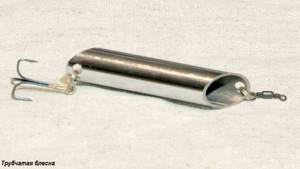
Spoon tube: types, materials, technological process
Spoons, spinners, balancers, edible rubber - the market offers fishermen a huge number of artificial baits of different shapes, sizes, and prices. Although more recently, the catch depended solely on the observation and ingenuity of the fisherman. A tube spoon is a catchy bait that can be made at home if you have the material and tools. In addition to being effective in catching freshwater predators - pike perch, pike, perch, this homemade artificial bait will cost the fisherman disproportionately less than, for example, silicone twisters, wobblers and similar imports.
The ease of manufacturing tubular spinners allows you to “stamp” several dozen baits in a short period of time, which will give an advantage when catching a predator in snags, where such a thing as a hook with the subsequent loss of a homemade product is not uncommon. We’ll figure out what and how to make a spinner tube from, and also answer a number of questions related to this topic.
Types of tubular spinners
- Hollow baits are the easiest to make. Used for deep fishing or in strong water currents. The “tube” has low lateral maneuverability, and therefore it is possible to quickly navigate through the bottom layers.
- Tubes made with a sealed end are not used so often. This type has increased resistance at the end, and therefore, when wiring, the displacement reaches 30 or even 40 centimeters. But there is also an advantage of this bait - a passive predator may be interested in the prowling game, as well as the specific sound that the hollow part of the bait makes.
- The loaded spoons are half or a third filled with material. Lead makes a good filler. This type of bait is rarely used. It is customary to take this tackle only when you need to cast over a long distance during strong winds. The device has just enough weight for a long throw.
- Another common modification is the noise type. To make it, the ends are sealed and a lead pellet is placed inside. When wiring is carried out, the tackle will make rattling sounds that will interest the predator. Such tube spinners, for example, work well for pike perch, as well as for pike or perch.
Various attack angles of spinners
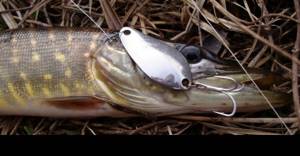
The next two pictures show the angles of the spinners. These are recommended angles, approximate. Only water will tell you the real angles; only on a pond can you test the action of the bait. Unfortunately, even a filled bathtub does not always correctly reflect the play of the spinner.
Please note that on one spoon the cutting angles are parallel, and on the other they are multidirectional, and even with different angles of attack. This does not mean that this should be done for a hollow spoon, but for a solid one; various variations are possible. Some craftsmen even make such spoons as composite ones.
What metal are lure tubes made of?
Typically, aluminum or copper is used to make tubing tackle. A homemade aluminum spoon will ultimately weigh 7 grams, and a copper tube spoon will weigh 14. But you can also use other materials: aluminum, copper, brass, steel and alloys.
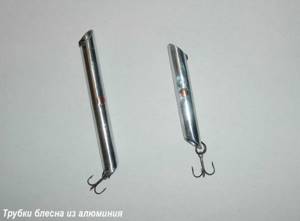
A stainless steel spoon will be a good bait, since it will not corrode in the water and thereby cover the pattern.
Making your own bait
The advantage of making a spinner out of a tube with your own hands is simplicity. It is difficult to make different types of spinners or spinners and not all fishermen will have the desire to buy them in stores. And you can make pipe bait yourself quite quickly and in large quantities.
This means that catching fish will not be overshadowed by its loss. If you want to catch pike perch in a snag area where it likes to live, then it is better to take more of these homemade products, because many of them will get caught on a snag and disappear.
Follow the instructions:
- To make the base, you will need to find a metal tube with a wall thickness of 0.8 mm. The diameter should be 8 or 10 mm.
- We cut off a piece 70 mm long from the workpiece.
- We take a hacksaw for metal and cut a piece from one edge at an angle of 70 degrees, and cut the other end at 20 and 22 degrees. The cut must be cleaned with a file, needle file or sandpaper. Burrs should be removed and the edges smoothed.
- In the cut parts we drill holes for winding rings with a diameter of 1 mm. We attach a swivel with a winding ring to the front edge, which has an obtuse cut angle. A winding ring with a tee is mounted to the second.
- If you want to catch pike perch, you need to use very good hard and sharpened hooks, since the fish has a hard palate.
Equipment for a homemade vertical spoon from a tube
The rigging of a homemade spoon spoon from a tube for vertical trolling is shown in the picture above in the text and does not need any special explanation, but for novice fishermen I will give a couple of tips.
In the drawing, the internal cavity of the tube, filled with solder or lead, is shaded with oblique lines. After pouring and cooling the lead, drill two holes with a diameter of 2 mm to mount the tee and swivel on the tail and nose ends of the carrier tube.
The holes are drilled along the longest line of the length of the homemade tubular spoon, a couple of millimeters away from both ends of the tube.
Next comes manual grinding and equipping the bait with attachments through winding rings. After that, a do-it-yourself spoon made from a round tube can be considered ready for vertical trolling.
Making a composite spoon
- We use a tubular blank and divide it into three parts.
- On the parts you should carefully cut the protrusions, in which you then drill a hole.
- You can now pass rivets through these holes, and then connect the prepared elements. The bait will yaw and bend, which will attract the attention of predatory fish.
Immediately before fishing, you need to clean the surface with sandpaper to get rid of oxides.
A do-it-yourself spinner for salmon, for example, is also suitable for other predatory fish.
Manufacturing
To make a tube spinner for pike perch at home, the craftsman will need:
Tools:
- hacksaw for metal;
- file;
- vice;
- sandpaper;
- drill with thin drill bits.
Materials and accessories
The material used is aluminum or copper tubes of the required diameter . It should be remembered that the specific gravity of copper is almost twice as high as that of aluminum, and be guided by this when making bait.
Lead is necessary in the manufacture of the corresponding types of spinners.
Winding rings are used to attach hooks to the lure.
Treble hooks are a necessary element of the spinner equipment.
Process
- Preparation of the workpiece. Using a hacksaw for metal, a piece of tube of the required length is cut. The smallest spoons have a length of 50 mm and show excellent results when catching pike perch in the wilderness. The most commonly used lures are 70 mm long, although spinners 100-110 mm long are also quite common. The cutting angle of the front part (the one where the fishing line is then attached) of the spoon is 30-60 degrees (usually about 50), the rear part (the place where the tee is attached) is 20-25 degrees.
- Workpiece processing.
The edges of the cuts are cleaned with a file and then with sandpaper. - Drilling holes.
Holes with a diameter of 1-1.5 mm are drilled in the front and back of the spoon. - Equipment with tees.
Winding rings are threaded into the holes, to which, in turn, tees are attached. - Loading the spinner.
The manufacture of tube spinners of another type includes the same steps; the process only includes soldering the front part for a bait with a sealed front end, or adding acoustic elements followed by soldering for noise spinners. If you need to make a loaded spoon, then its front part is filled with lead by a third or half.
Expert opinion
Knipovich Nikolai Mikhailovich
Zoologist, hydrobiologist. I am interested in fishing at a professional level.
Interesting! Most anglers make a hole in the front of the spoon at its “far” end, so to speak. But if you drill a hole on the near part of the cut, the game of the bait changes significantly, which can be useful when catching a passive predator.
Making a composite spoon-tube
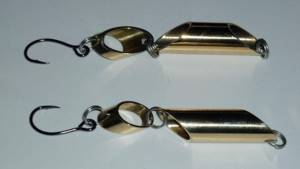
The manufacturing process is more complex. It consists of the following steps:
- Cut out a piece of tube 80 mm long and make cuts at its ends in the same way as when making a regular tubular spoon.
- Cut the workpiece into three parts, maintaining the same angles as on the initial workpiece.
- They make special “ears” - protrusions designed to connect the segments to each other. This is a very painstaking job and is done with a file.
- Drill holes at the front and rear ends of the tube and in each eye.
- Connect the three parts of the bait using rivets.
- The lure is equipped with rings and tees.
The sizes of the segments can be of different sizes : the decision remains with the master. You can also use various metals in the manufacture of bait components.
Additional features
What remains is tuning the tube spinner. Most often, anglers use a tee equipped with an artificial fly . The latter serves to stabilize the play of the spinner during retrieval and is an additional element that attracts predators. Sometimes, instead of a tee, a single hook equipped with a twister . When fishing in winter, it is highly advisable to put 2-3 multi-colored cambrics or use a hook with a three-color drop.
Decoration of the bait
To catch perch or pike with a self-made spoon, you need to properly decorate the bait to attract fish. To do this, you can attach a twister, a brightly colored woolen thread, tinsel or a piece of silicone to the tube. Attaching an additional leash will also be effective.
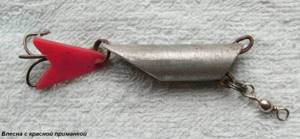
To make the bait more attractive to a predator, you can additionally color the tackle. It is enough to draw the eyes and draw a few transverse stripes. Often fishermen paint one side of the part in bright shades, while leaving the other side in light colors.
Purpose of “beauty” on the bait
- At shallow depths, the fish will begin to pick up a color that will provoke an attack.
- Underwater, the patterns on the gear will appear more voluminous.
- Additional “canopies” will create strong vibrations that the predator will pick up.
- The oscillations will also imitate the movements of the worms.
Winter vertical lures for pike perch
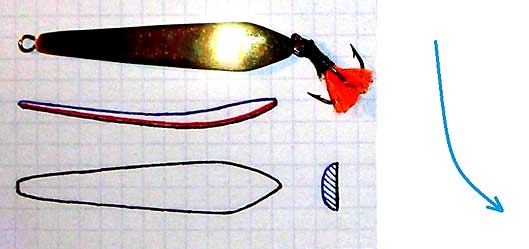
Sheer spoons for catching pike perch are usually called winter ones, but many fishermen catch fanged predatory fish with a vertical rod in the summer. It is better to fish with a fishing rod about a meter long from a rubber boat, rafting down the weak current of the river.
Having felt the knock on the “winter” spoon or caught a pike perch, you can put the floating craft on one anchor and fish the “suspicious” place all around, given that pike perch is a schooling fish. True, this does not mean at all that a pike perch will definitely land on a steep pike perch spoon.
Instead of pike perch, large perch, pike and other predatory fish may covet the double (tee) hooks of a homemade or purchased pike perch bait, which, I hope, should not upset us too much. In deep holes in the summer, pike perch can be caught well with tubular vertical spoons.
Drawing of a sheer pike perch spoon pattern
The photo under the title of the article shows a drawing of a pattern for a homemade sheer lure for pike perch with a movable tee equipped with a panicle made of woolen threads. Let them be called “winter” on the pages of this topic.
The figure next to it shows the characteristics of a long vertical line with a winter fishing rod with vertical equipment for a bait made according to the drawing.
We will talk further about winter pike perch, vertically gliding spoons. Archives with sets of drawings of patterns for winter homemade spinners for pike perch, pike perch and pike perch can be downloaded from the Main page.
For the convenience of further tracking the text, download the archive of drawings of winter pike-perch spinners. And making a vertical winter lure for pike perch with a minimal set of tools is not at all difficult, even for a novice fisherman.
Personally, during my long life I have caught and continue to catch fish in winter and summer, including pike perch, only with my own made bait. Otherwise, where would I have gotten the drawings of perch, zander and pike homemade vertical lures?
How to fish with a tubular spoon
Follow these guidelines:
- To catch low-active fish, use tackle with a length of 50 mm. When the zhor begins, fish such as pike perch, for example, become active. During this period, use spinners from 90 to 110 cm in length. This way you can cut off small things and lure large prey.
- If you are fishing in a strong current, then use only hollow tubes. When the water is calm, you can choose models with sealed ends.
- When wiring, you need to pause with periods of intense rewinding. Thus, the spoon will imitate the behavior of a weakened or wounded small fish. It will periodically freeze near the bottom at a certain angle, and then scour from side to side. This will provoke the predator.
- If there are many derailments, then the tee is replaced with a model that has wider hooks, as well as a shorter fore-end.
